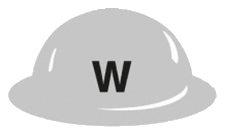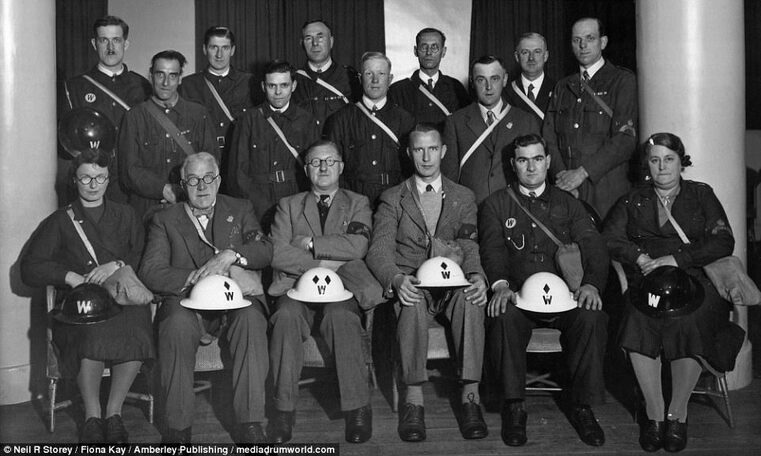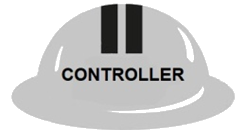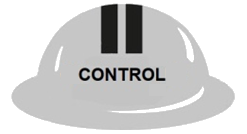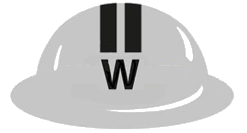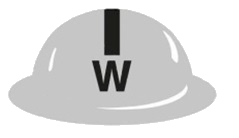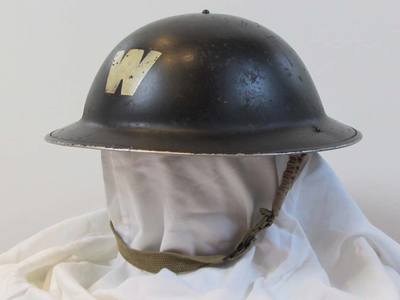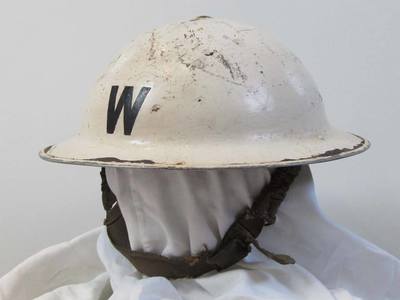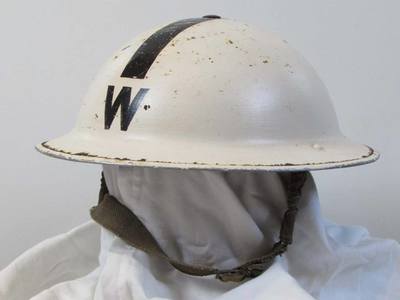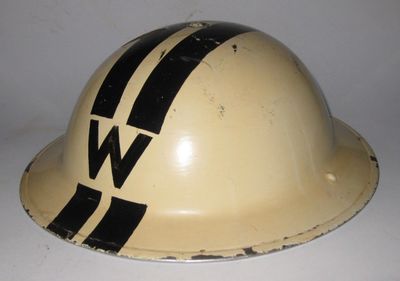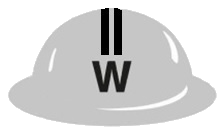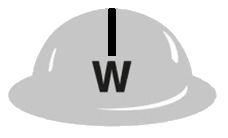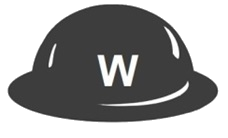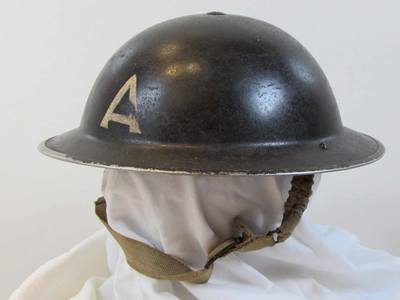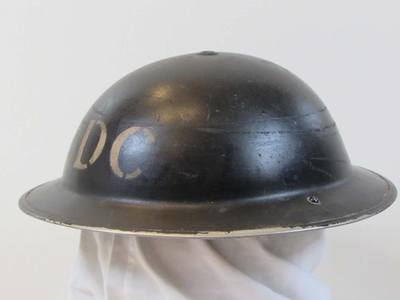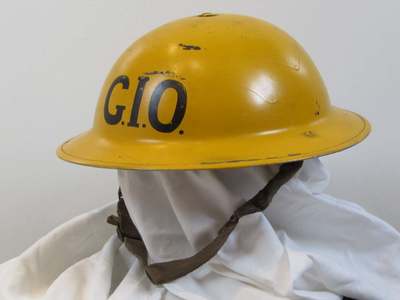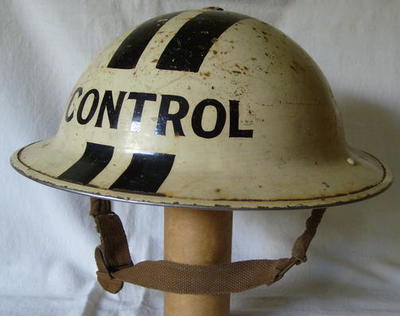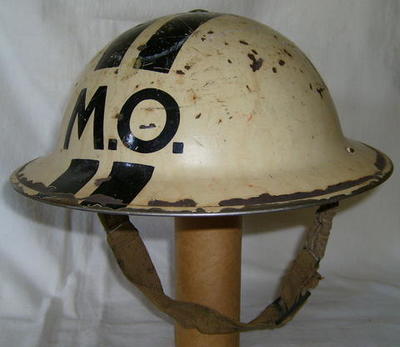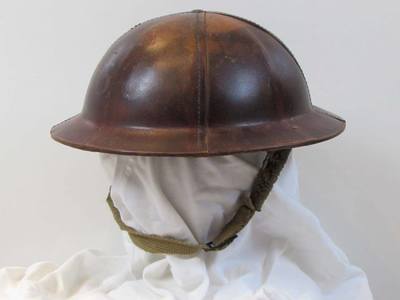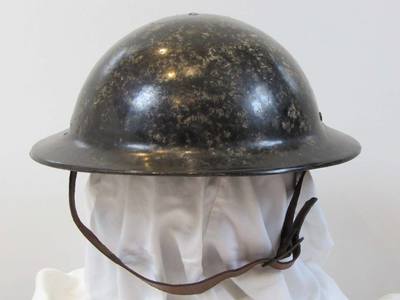WW2 Home Front, Air Raid Warden, ARP & Civil Defence Helmets & Markings
During the second world war thousands of different markings were displayed on ARP, Civil Defence and home front helmets. Whilst some markings (for example, air raid warden 'W', rescue 'R' and ambulance 'A', etc) are commonly seen there existed many variations and unique markings from local authorities and factories.
The sheer number and variety of markings found on Mk. II helmets (plus a small number of first world war vintage Mk. I* helmets) during the war could easily be a website unto itself. A book that covers hundreds of these helmets and markings is Helmets of the Home Front.
Below is an outline of the common helmet markings on Civil Defence helmets plus the markings used to display seniority. In London black bands were used whilst outside the capital diamonds were introduced in July 1940. The diamonds were replaced in mid-1942 when the London scheme was adopted nationwide.
There is a section for markings found on Fire Guard helmets.
The sheer number and variety of markings found on Mk. II helmets (plus a small number of first world war vintage Mk. I* helmets) during the war could easily be a website unto itself. A book that covers hundreds of these helmets and markings is Helmets of the Home Front.
Below is an outline of the common helmet markings on Civil Defence helmets plus the markings used to display seniority. In London black bands were used whilst outside the capital diamonds were introduced in July 1940. The diamonds were replaced in mid-1942 when the London scheme was adopted nationwide.
There is a section for markings found on Fire Guard helmets.
Early-WW2 ARP / Civil Defence Helmet Diamond Ranks
Black diamonds to denote seniority (on the front of the helmet only) were introduced in July 1940 following the publication of Air Raid Precautions Training Bulletin No. 3 1940 which detailed how helmets were to be marked (for areas outside of London as London had adopted a scheme of black bands running front to rear, see below). The diamonds (of one-inch sides and spaced one inch apart) were placed in a horizontal row above the service lettering.
Diamonds continued until the summer of 1942 and were replaced by the London system of black bands (bars or stripes). There is evidence of some rare black helmets with white diamonds but the specific role/rank is currently unknown. Given the large number of helmets that exist with diamonds still on them, a large number of owners didn't update their helmets.
Headquarters Staff were to wear white helmets with red lettering, for example REGIONAL COMMISSIONER and DEPUTY REGIONAL COMMISSIONER. Regional headquarter staff would also use that region's CD number added as a roman numeral.
Members of Group Headquarters, Control Room Staff and Intelligence Officers had red helmets with white lettering, for example, CONTROLLER and DEPUTY CONTROLLER. The red helmets were later replaced by white helmets and black bars and examples can be found showing the red helmets having been repainted this colour.
Personnel involved in dealing with gas were to wear yellow helmets with black diamonds. Gas Identification Officers (G.I.O) wore two diamonds and Senior Gas Advisors three diamonds.
Diamonds continued until the summer of 1942 and were replaced by the London system of black bands (bars or stripes). There is evidence of some rare black helmets with white diamonds but the specific role/rank is currently unknown. Given the large number of helmets that exist with diamonds still on them, a large number of owners didn't update their helmets.
Headquarters Staff were to wear white helmets with red lettering, for example REGIONAL COMMISSIONER and DEPUTY REGIONAL COMMISSIONER. Regional headquarter staff would also use that region's CD number added as a roman numeral.
Members of Group Headquarters, Control Room Staff and Intelligence Officers had red helmets with white lettering, for example, CONTROLLER and DEPUTY CONTROLLER. The red helmets were later replaced by white helmets and black bars and examples can be found showing the red helmets having been repainted this colour.
Personnel involved in dealing with gas were to wear yellow helmets with black diamonds. Gas Identification Officers (G.I.O) wore two diamonds and Senior Gas Advisors three diamonds.
White Helmet |
Plus one diamond |
Plus two diamonds |
Plus three diamonds |
Post Warden F.A.P. Leading Hand* Rescue Party Foreman* Decontamination Squad Leader |
Head Warden |
Divisional Warden** |
Chief Warden & Deputy M.O.H. & Deputy Borough Surveyor & Deputy |
* Detachment Leaders to also wear an armband with "DETACHMENT LEADER".
** London areas had District Wardens whilst areas outside of the capital had Divisional Wardens.
** London areas had District Wardens whilst areas outside of the capital had Divisional Wardens.
WW2 ARP Air Raid Warden White Helmet With Black Band Markings
The most widely recognised Air Raid Warden's helmet insignia is the two-inch high 'W'. Depending on the air raid warden's rank he would have either a black helmet with white 'W' or a white helmet with black 'W' (plus one or two one-inch bars (separated by a half-inch gap) to denote seniority within the wardens' service). However, there are a thousands of helmets from various localities with a variance of lettering fonts and band sizes.
The scheme used across London's civil defence boroughs of using black bands front to rear (with space front and back for the service letter) was made nationwide in July 1942. Diamonds were to be replaced by bands (however, given the number of helmets that have survived with diamonds on them, it appears not everyone chose to repaint their helmet).
The scheme used across London's civil defence boroughs of using black bands front to rear (with space front and back for the service letter) was made nationwide in July 1942. Diamonds were to be replaced by bands (however, given the number of helmets that have survived with diamonds on them, it appears not everyone chose to repaint their helmet).
Plain black |
Warden |
Plain white |
ARP Officers, Post Wardens (plus deputies), Rescue, Decontamination and Stretcher Party leaders |
White with single black stripe |
District/Divisional Wardens (and deputies) |
White with double black stripe |
Controllers, Control Staff, Chief Wardens (and deputies), Medical Officers of Health (M.O.) |
Some Divisional Wardens had 'D.W.' and some Post Wardens also had 'P.W.' inscribed on their helmets. Certain Warden/Fire Guards used 'W/FG' on grey helmets (see below). Given the nature of the Civil Defence General Services and how authorities implemented regulations there exists a remarkable wide range of helmet markings.
The Ministry of Home Security Civil Defence Helmet Recommendations 1943
|
For senior supervisory offers, two black bars each 1 inch wide and 1/2 inch apart, painted from front to back across the top of the helmet; they are broken front and back, for the insertion of the appropriate letter indicating service or rank.
|
For junior supervisory officers with more than two chevrons, one black bar, 1 inch wide, painted across the top of the helmet and broken for the insertion of the appropriate letter.
|
For junior supervisory officers, entitled to two chevron stripes, a white helmet with no bars.
|
For general personnel the helmet is as issued (black) with service lettering in white All officers wear white helmets with service lettering in black.
|
|
London region: officers entitled to three chevrons stripes wear one black bar 2 inches wide, which applies also to head fire guards. Deputies and Senior Fire Guards have a single 1 inch bar. Helmets of head and senior Fire Guards are painted grey to correspond with civilian helmets (Zuckerman) issued to Fire Guards.
|
For more information on how rank markings on helmets developed during the second world war see this blog post.
WW2 ARP & Civil Defence Service MK. II Helmet Markings
Civil Defence Service |
Helmet letter |
Ambulance |
A |
First Aid Post / First Aid Parties |
FAP |
Decontamination (Gas) |
DC |
Messenger |
M |
Stretcher Party (London) |
SP |
G.I.O. (Gas Identification Officer)* |
G.I.O. |
Shelter Warden |
SW |
Shelter Marshal |
SM |
Casualty Service |
CS |
Mobile Unit |
MU |
Rescue (plus Light & Heavy) |
R (LR & HR) |
Warden |
W |
Warden/Fire Guard |
W/FG |
* Gas Identification Service (G.I.S.) used pre-war and also in 1939, 1940 and 1941.
WW2 Report & Control and Medical Officer Helmet Markings
WW2 Civil Defence Repair Services Helmet Markings
Generally all the following helmets were black with lettering in white. The white RP with black band was a Repair Party Leader.
Repair Party |
Helmet letters |
Repair Party / Water |
RP/W |
Repair Party / Electricity |
RP/E |
Repair Party / Gas |
RP/G |
Repair Party / Telephones |
RP/T |
Repair Party / Sewage |
RP / S |
Repair Party |
RP (often a white helmet with a black band) |
Repair Party / Roads |
RP/R |
Grade 2 Quality Civil Defence Mk. II Helmets With Rim Holes
Following the evacuation from Dunkirk in the summer of 1940, raw materials were severely stretched and to provide enough helmets for civil defence personnel Grade 2 helmets were manufactured. These Mk. II Grade 2 mild steel austerity helmets had holes drilled in the rim (near the chinstrap rivet) to indicate the quality of the steel used in the manufacture. The more holes the lesser the resistance to ballistic impact. As the war progressed and more metal supplies became available the need for these sub-standard helmets decreased and standard Grade I Mk. I helmets were made and issued.
There is no consistency on who was issued these helmets. It was not the case that, for example, all Mk. II 2As went to the Home Guard, air raid wardens received Mk. II 2Bs, or that Mk. II 2Cs went to say, the Observer Corps. Some claims have been made that Mk. II 2Ds were for Fire Watchers but I have not found any documentary evidence to back this claim. The usual case in the civil defence services was you got what available from stores.
There is no consistency on who was issued these helmets. It was not the case that, for example, all Mk. II 2As went to the Home Guard, air raid wardens received Mk. II 2Bs, or that Mk. II 2Cs went to say, the Observer Corps. Some claims have been made that Mk. II 2Ds were for Fire Watchers but I have not found any documentary evidence to back this claim. The usual case in the civil defence services was you got what available from stores.
Helmet designation |
Number of holes in rim |
Mk. II 2A |
1 |
Mk. II 2B |
2 |
Mk. II 2C |
3 |
Mk. II 2D |
4 |
Private Purchase Home Front Helmets
A number of helmets were produced for purchase by the public.
I am always interested in adding photos of home front helmets to this page - simply send me a mail. Please follow the style of taking a photo against a white background if possible.
